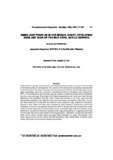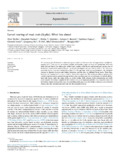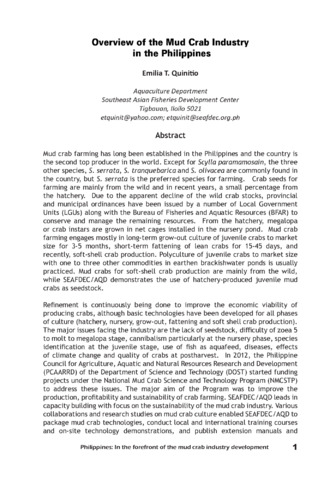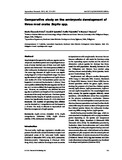Amino acid profiles in the midgut, ovary, developing eggs and zoea of the mud crab, Scylla serrata

Associated URL
evols.library.manoa.hawaii.eduDate
2004Author
Page views
154Metadata
Show full item record
Share
Abstract
Culture of the mud crab, Scylla serrata, is beset by low and inconsistent survival of larvae in spite of the high fecundity of crab breeders. The nutrition of the embryo and pre-feeding zoea depends on what is stored in the egg. The protein and free amino acid contents of the midgut gland, ovary, eggs, pre-feeding zoea, live food and a maintenance diet for broodstock were analyzed by HPLC. The maintenance diet had lower arginine, histidine, methionine, threonine and tryptophan than the ovary and egg. The midgut had higher phenylalanine and valine and lower leucine, methionine and tryptophan than the ovary. Amino acid profiles in the ovary, egg and zoea showed that methionine was highest in the ovary and leucine was highest in the zoea. Low val- ues were observed for isoleucine and valine in ovary, arginine in egg, methionine and pheny- lalanine in zoea. When live foods were compared to zoea, histidine in Brachionus, leucine and tryptophan in Artemia, and arginine, leucine and valine in Acartia were low. Essential free amino acids in fertilized eggs were 2.5 times higher than in unfertilized eggs. Arginine, histidine, lysine, methionine, tyrosine and threonine decreased with egg embryogenesis, suggesting that these are the major free amino acids utilized as the egg develops. Information on egg and zoea amino acids can be used to predict viable crab eggs while information on amino acid profiles in the ovary, egg and zoea can be used to develop broodstock diets. Identification of limiting amino acids in live foods can be used to develop larvae diets.
Suggested Citation
Peñaflorida, V. D. (2004). Amino acid profiles in the midgut, ovary, developing eggs and zoea of the mud crab, Scylla serrata. The Israeli Journal of Aquaculture-Bamidgeh , 56(2), 111-123. http://hdl.handle.net/10862/2023
Subject
Taxonomic term
Collections
- AQD Journal Articles [1214]
Related items
Showing items related by title, author, creator and subject.
-
Larval rearing of mud crab (Scylla): What lies ahead
Waiho, Khor; Fazhan, Hanafiah; Quinitio, Emilia T.; Baylon, Juliana C.; Fujaya, Yushinta; Azmie, Ghazali; Wu, Qingyang; Shi, Xi; Ikhwanuddin, Mhd; Ma, Hongyu (Elsevier, 2018)The increasing global demand for mud crabs (genus Scylla) and threats to the wild populations highlight the urgency of fully rearing them in captivity. Despite considerable progress in mud crab production, most crab farms ... -
Overview of the mud crab industry in the Philippines
Quinitio, Emilia T. (Aquaculture Department, Southeast Asian Fisheries Development Center, 2017)Mud crab farming has long been established in the Philippines and the country is the second top producer in the world. Except for Scylla paramamosain, the three other species, S. serrata, S. tranquebarica and S. olivacea ... -
Comparative study on the embryonic development of three mud crabs Scylla spp.
Ates, Maria Charmela D.; Quinitio, Gerald F.; Quinitio, Emilia T.; Sanares, Roman C. (Blackwell Publishing, 2012)Morphological changes in the embryos, egg size and development, incubation period and morphological structures of newly hatched zoea of three mud crab Scylla species were determined. The three species exhibited similar ...





